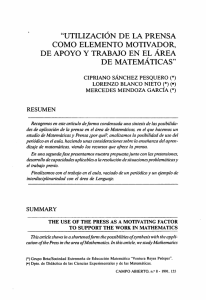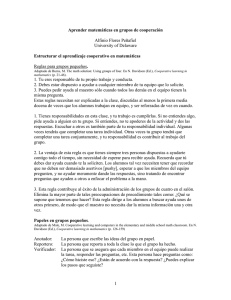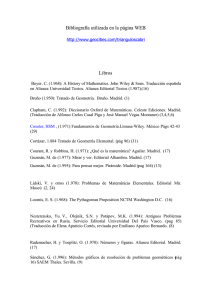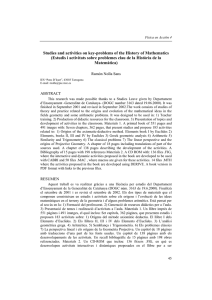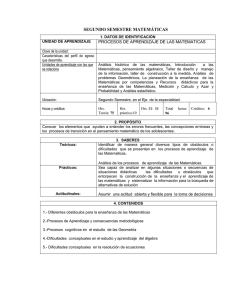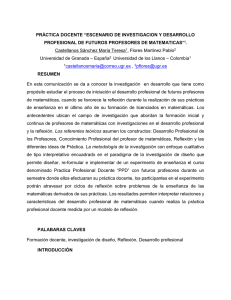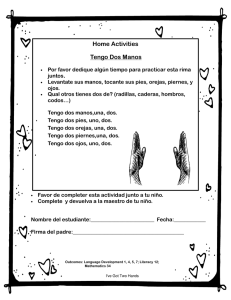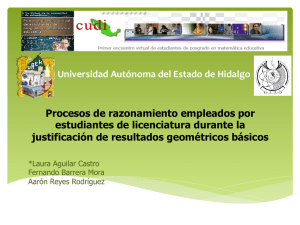Tras la celebración en el presente año de un congreso de la
Anuncio
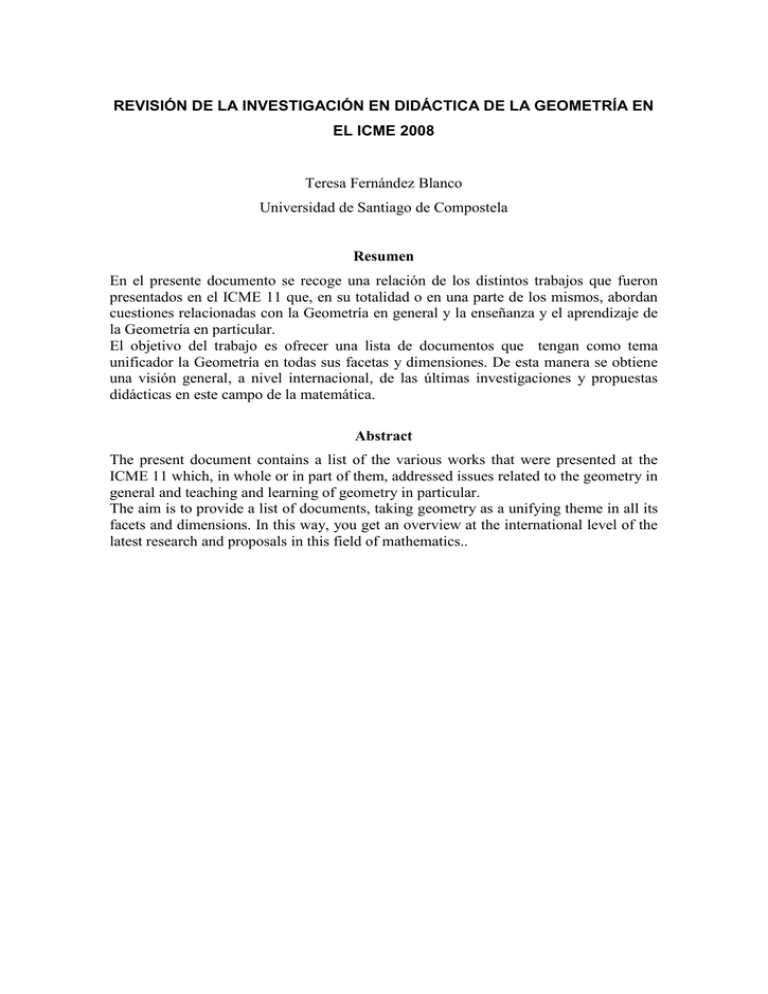
REVISIÓN DE LA INVESTIGACIÓN EN DIDÁCTICA DE LA GEOMETRÍA EN EL ICME 2008 Teresa Fernández Blanco Universidad de Santiago de Compostela Resumen En el presente documento se recoge una relación de los distintos trabajos que fueron presentados en el ICME 11 que, en su totalidad o en una parte de los mismos, abordan cuestiones relacionadas con la Geometría en general y la enseñanza y el aprendizaje de la Geometría en particular. El objetivo del trabajo es ofrecer una lista de documentos que tengan como tema unificador la Geometría en todas sus facetas y dimensiones. De esta manera se obtiene una visión general, a nivel internacional, de las últimas investigaciones y propuestas didácticas en este campo de la matemática. Abstract The present document contains a list of the various works that were presented at the ICME 11 which, in whole or in part of them, addressed issues related to the geometry in general and teaching and learning of geometry in particular. The aim is to provide a list of documents, taking geometry as a unifying theme in all its facets and dimensions. In this way, you get an overview at the international level of the latest research and proposals in this field of mathematics.. Revisión de la investigación en didáctica de la geometría en el ICME 2008 Introducción Dada la variedad de contribuciones diferentes que se permiten en un congreso de la dimensión del ICME 11, para realizar este trabajo nos hemos centrado en los dos epígrafes bajo los que se engloban la mayor cantidad de documentos: los Topic Study Groups y los Discussion Groups. El primero de ellos cuenta con 38 núcleos temáticos y el segundo con 28. Pese a que el citado congreso incluía ya núcleo temático específico sobre enseñanza y aprendizaje de la geometría, los grupos de trabajo o de debate se formaron atendiendo a una gran variedad de criterios (niveles de enseñanza, utilización de nuevas tecnologías, aplicaciones prácticas, razonamiento y prueba en matemáticas, etc) y en muchos de ellos aparecen diversos trabajos que tratan la geometría y que, por tanto, son de interés para esta recopilación. Cuando se realizó la selección de esta información, en la web de algunos de los núcleos temáticos todavía no se había cargado ningún documento, mientras que en otros no se incluía ningún documento de temática relacionada con la geometría, tanto de forma específica en el título como en el contenido del documento. Esto explica que en la relación no estén presentes la totalidad de los núcleos temáticos. También se observa que en algún caso se recoge el autor y el título del trabajo pero no se incluye el enlace que permita descargar el documento de la web correspondiente, debido a que no estaba disponible en ese momento o a que sólo se había incluido el resumen en la web. Comenzaremos presentando la relación de los documentos relacionados con la geometría en el primer bloque (Topic Study Groups), indicando los seleccionados dentro de cada uno de los núcleos temáticos, para luego incluir la relación correspondiente al segundo grupo (Discussion Groups). Se ha intentado unificar la presentación de forma que aparezca el nombre del autor o autores, que contiene el enlace al documento, y a continuación el título del trabajo. Topic study groups Dentro de los 38 núcleos temáticos hay dos que resultan especialmente interesantes para los miembros del grupo, el TSG 12 sobre enseñanza y aprendizaje de la Geometría, y el TSG 18, sobre prueba y demostración en la enseñanza de las Matemáticas. En este último núcleo aparecen destacados aquellos trabajos que versan sobre prueba y demostración en Geometría, tema que ha interesado a nuestro grupo de investigación en estos últimos años. TSG 1: New Developments And Trends In Mathematics Education At Preschool Level Fernández Blanco, T. Catherine Taveau: Discovering geometry at preschool level. Anna Chronaki: Technology use and geometry development in the early yearsan analysis based on the human-media-geometry unit. Fenna van Nes & Jan de Lange: Relating spatial structures to the development of kindergartner’s number sense. TSG 2: New Developments And Trends In Mathematics Education At Lower Secondary Level Keijzer: Deca is ten. Skilbecq: Apprenti géomètre, an instrument for learning geometry and magnitudes measurement. Sugawara: Improving mathematics lesson study: why japanese teachers use dart games for the introduction of area learning. TSG 5: New Developments And Trends In Mathematics Education At Tertiary Level Sam O King: Staff perceptions of the one-tablet mathematics classroom. TSG 12: Research And Development In The Teaching And Learning Of Geometry En este núcleo temático no fue posible obtener versiones extendidas de los trabajos, pero sí se pueden descargar los resúmenes de los mismos. Liu Xiaomei: Study on the characteristics of development rules of pupil's spatial abilities. Walter Whiteley, Margaret Sinclair. Stewart Craven, Lily Moshe, Anna Dutfield, and Melissa Seco: Helping elementary teachers develop visual and spatial skills for teaching geometry. Brenda Strassfeld: High school mathematics teacher's beliefs about the teaching of geometry. Anna Marie Conner: Argumentation in a geometry class: aligned with the teacher’s conception of proof. Aiso Heinze, Stefan Ufer, Ying-Hao Cheng, and Fou-Lai Lin: Geometrical proof competency and its individual predictors – a taiwanese – german study. Jesús Hernandez Pérez: Dinamic geometrie software and escher techiques in la alhambra. Revisión de la investigación en didáctica de la geometría en el ICME 2008 D. Goreve, I. Gurvich, M. Barabash: Solving construction problems of different levels of insight: how students of various levels profit from the computerized environment?. Francesca Martignone: Mathematical machines laboratory activities. Ryan Smith, Karen Hollebrands, Kathleen Iwancio, and Irina Kogan: The affects of a dynamic program for geometry on college students’ understandings of properties of quadrilaterals in the poincaré disk model. Francisco Olvera, Gregoria Guillén and Olimpia Figueras: Teaching geometry in elementary school. Jiří Vaníček: Procedural part of geometrical objects in concepts and strategies of primary school. Deborah Moore-Russo: Teachers exploring and re-forming the concept of parallel. Wang Linquan: Chinese reformation of mathematics curriculum in geometry. Tomoko Yanagimoto: An approach to teaching knot theory in schools. Helena Boublil: The challenge: didactic of geometry to prospective teachers. TSG 17: Research And Development In The Teaching And Learning Of Advanced Matematical Topics Arnoux and Finkel: Using mental imagery processes for teaching/searching in mathematics and computer science. Selden, McKee and Selden: The relation between affect and the proving process. TSG 18: Reasoning, Proof And Proving In Mathematics Education Bartolini Bussi, M. G.: Experimental mathematics and the learning of proof . Rodrigues, M.: Reasoning and proof in classroom (9th grade). Ufer, S. & Heinze, A.: Development of geometric proof competency from grade 7 to 9 a longitudinal study. Yang, K-L. & Wang, L-W.: Propositions posed under a proof without its proposition. Camargo Urib, L. & Gutierrez, A.: Some aspects of the sociocultural practice of proving in a university course with support of CABRI. Nunokawa, K. & Fukuzawa, T.: Operating on and understanding of problem situations in proving. Fernández Blanco, T. Miykawa, T. & Herbst, P.: Why some theorems are not proven in geometry class: dispositions and constraints. Gal, H. & Lew, H-C.: Is a rectangle a parallellogram? Towards a bypass of Van Hiele level 3 decision making. TSG 19: Research And Development In Problem Solving In Mathematics Education Paek, P.: A technology-based investigation of United States high school student mathematical problem solving. Barrera – Reyes: Formulating mathematical conjectures in learning activities, assisted with technology. Hernández–Villafañe: Cognitive and metacognitive processes of pre-service mathematics teachers while solving mathematical problems. TSG 20: Visualization In The Teaching And Learning Of Mathematics Presmeg: An overarching theory for research in visualization in mathematics education. Acuna Soto and Larios Osorio: Prototypes and learning of geometry. A reflection on its pertinence and its causes. Agathangelou et al.: The impact of iconic representations in solving mathematical one-step problems of the additive structure by primary second grade pupils. Gagatsis et al.: The axis of reflective symmetry as representation in mathematics learning. Hsu: Learning opportunities of reasoning: the interplay between gestures and diagrammatic properties. Posada: Monstrations as a complementary concept for visual thinking: implications in the teaching and learning of elementary geometry. Soto-Andrade: Mathematics as the art of seeing the invisible. van Blerk: Learners’ visual recognition of geometry theorems. TSG 22: New Technologies In The Teaching And Learning Of Mathematics Chacon & Guevara: Three-dimensional objects. DeLasPenas et al.: On maximizing technology resources. Gravina: Dynamical visual proof what does it mean. Jahn & Flores: Exploring three-dimensional objects. Karrer & Jahn: Studying plane linear transformations or designing a teaching unit in the cabri 3d environment. Revisión de la investigación en didáctica de la geometría en el ICME 2008 Psycharis & Kynigos: Exploring angle through geometrical constructions in 3d space. Mann: Video-based learner assistance in learning environments for geometry. Soury-Lavergne: Deductive reasoning and instrumental genesis of the drag mode in dynamic geometry. Araya & Navarro: Three-dimensional objects handling. Laborde: 3D-environment, dynamic math: design issues. TSG 23: The role of history of mathematics in mathematics education Snezana L.: History of mathematics making its way through the teacher networks. Mrabet S.: The development of Thales theorem throughout history. TSG 24: Research On Classroom Practice Hesiquio: The explanation of the teachers. An experience study of the notion of similarity in upper middle level. Soto-Johnson, Wheeler & Cribari: The impact of written reflections in a geometry course for preservice elementary teachers. TSG 26: Learning And Cognition In Mathematics: Students´ Formation Of Mathematical Conceptions, Notions, Strategies, And Beliefs Despina Portari P: Prospective primary teachers’ conceptions of axial symmetry. Antonini:_Students’ use of reductio ad absurdum. Matsuo & Silfverberg:_Similarities and differences between japanese and finnish 6th and 8th graders’ ways to interpret and apply the definitions of geometric concepts. BizaI:_Models of students' conceptions about the tangent line. White & Mitchelmore: Teaching for abstraction: then and now. TSG 27: Mathematical Knowledge For Teaching Addington: Measurement and multiplicative thinking in prospective elementary teachers. Amato: Avoiding the teaching of mathematics. TSG 28: Inservice Education, Professional Life And Development Of Mathematics Teachers Freitas_Fiorentini: Investigating and writing in the professionaldevelopment of mathematics teacher. Fernández Blanco, T. Nacarato_Grando: Formative processes: sharing learning experiences in geometry. Passos_Lamonato: Continuing professional training of mathematics teachers: learning through mathematics investigation. TSG 29: The Preservice Mathematical Education Of Teachers Abramovich_Brouwer: Exploring hidden context of pre-service teachers’ intuitive ideas in mathematics. TSG 31: Language And Communication In Mathematics Education Kim: The process of negotiation of proofs acceptable in a mathematics classroom. Leung & Lai: An exploratory study into chinese and english speaking children’s visual perception. TSG 32: Gender And Mathematics Education Paek: Some factors contributing to gender differences in the mathematics performance of united states high school students. Pourkazemi: Gender, gifted & talented students at Iran’s state universities. TSG 33: Mathematics Education In A Multilingual And Multicultural Environment Bakalevu, S.: Coping with multicultural & multilingual mathematics classes. La Ferla V., Sinan Olkun, Funda Gönϋlateş and Meltem Ceylan.: A multicultural look at mathematics. Peralta, B. M. and Ortiz H.M.: In the lines and abos muiscas, the daily life of the class of mathematics. Vargas–Vásquez, Xaab Nop.: An evaluation of the apprenticeship of ayuujk students in the xaam school. Abulikemu, A.: Mathematics education is in life of uighur students of xinjiang of china—to development mathematics textbooks for depressed and minority area by multi-resources of curricula. TSG 34: Investigación Y Desarrollo En La Tarea De Diseño Y Análisis Lee-Leung: Variational tasks in dynamic geometry environment. Goddijn: Polygons, triangles and capes designing a one day team task for senior high school. Comparison LeeLeung-Goddijn: Comparing our very different contributions: o Variational Tasks in Dynamic Geometry Environment Arthur Lee, Allen Leung Revisión de la investigación en didáctica de la geometría en el ICME 2008 o Polygons. Triangles and capes. Designing a one day team task for senior High School Aad Goddijn TSG 35: Research On Mathematics Curriculum Development Thompson & Senk: Why documenting the implementation of curricula matters. Tarp: Deconstructing the mathematics curriculum: telling choice from nature. Iwaskaki & Baba: Comparison of objectives between school mathematics in the western countries and that in the eastern countries – focusing on upper secondary education. TSG 36: Research And Development In Assessment And Testing In Mathematics Education Wu & An: Influence of the new mathematics textbooks on student achievement and attitudes in china. TSG 38: The History Of The Teaching And Learning Of Mathematics Alexander Karp: Back to the future: the conservative reform of mathematics education in the soviet union during the 1930s-1940s. Celia Leme & Wagner Valente: Students’ notebooks as a source of research on the history of mathematics education. Livia Giacardi: The school as a ―laboratory‖. Giovanni Vailati and the project for the reform of the teaching of mathematics in Italy. Taro Fujita & Keith Jones: The process of re-designing the geometry curriculum: the case of the mathematical association in England in the early 20th Century. : Defining the teachers’ knowledge: a discussion about examinations for primary and secondary school teachers in Brazil in the nineteenth century. Hélène Gispert: Two mathematical reforms in their context in twentieth century France: similarities and differences. Discussion groups DG4: Reconceptualizing The Mathematics Curriculum Ma Yun-peng: A reflection on the reconceptualization of mathematics curriculum for the nine-year compulsory education in mainland China. DG6: The Nature And Roles Of International Cooperation In Mathematics Education Fernández Blanco, T. Corine Castela: cooperation between the PUCV (pontifical universidad católica de Valparaíso) and the research laboratory DIDIREM. DG7: Dilemmas And Controversies In The Education Of Mathematics Teachers Hatice Akkoç, Fatih Ozmantar, Erhan Bingolbali (Turkey): Exploring the technological pedagogical content knowledge. Allan Tarp (Denmark): Concealing choices to teachers. DG9: Promoting Creativity For All Students In Mathematics Education Bradford_Hansen-Smith_USA: Wholemovement approach to creativity in math education. Istvan_Lenart_Hungary: Gifted and non-gifted students and teachers. Dace_Bonka_and_Agnis_Andzans_Latvia: First little steps on a god-knowshow long route. Angel_Homero_Flores_Samaniego_Mexico: Learning mathematics, doing mathematics: creativity in classroom? Emiliya_Velikova_Bulgaria: Promoting creativity for all students educational technology and multimedia usage. DG16: The Evaluation Of Mathematics Teachers And Curricula Within Educational Systems Glenda Lappan: The evaluation of curricula Manizade: Developing rubrics & measures for evaluation of mathematics teachers pedagogical content knowledge of geometry & measurement at the lower secondary level: delphi study. DG17: The Changing Nature And Roles Of Mathematics Textbooks: Form, Use, Access Ibarra: Too close, too far: mathematical knowledge and the knowledge of the textbook in geometry 6th and 7th egb year. DG18: The Role Of Ethnomathematics In Mathematics Education Kay Owens and Wilfred Kaleva: indigenous papua new guinea knowledges related to volume and mass. Milton Rosa: ―Freedom quilts‖: an ethnomathematical way of communication towards liberation. DG27: How Is Technology Challenging Us To Re-Think The Fundamentals Of Mathematics Education? Dorothy French: Tessellations, transformations and technology: teaching geometry in the digital age. Revisión de la investigación en didáctica de la geometría en el ICME 2008 Francisco Mattos, Luiz Carlos Guimarães, Rafael Barbastefano, Thiago Moraes: Collaboration scripts in geometry: a case study with tabulæ. Mikio Miyazaki, Chino Kimih, Hitoshi Arai, Fumihiro Ogihara, Tatsuo Morozumi, Ryuhei Katoh: Potentials of spatial geometry curriculum development with three-dimensional dynamic geometry software in lower secondary mathematics. Wei-Chi Yang: Increase our learning horizon with evolving technology. Yuriko Yamamoto Baldin: Some considerations about the preparation of teachers to use dynamic geometry software as didactical tool in spatial geometry.
